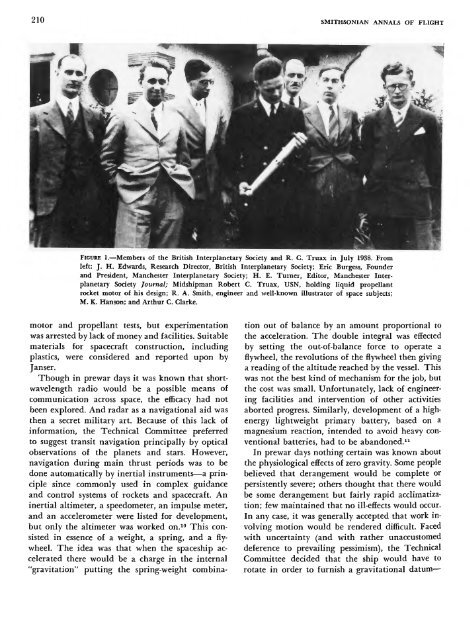FIRST STEPS TOWARD SPACE - Smithsonian Institution Libraries
FIRST STEPS TOWARD SPACE - Smithsonian Institution Libraries
FIRST STEPS TOWARD SPACE - Smithsonian Institution Libraries
You also want an ePaper? Increase the reach of your titles
YUMPU automatically turns print PDFs into web optimized ePapers that Google loves.
210 SMITHSONIAN ANNALS OF FLIGHT<br />
FIGURE 1.—Members of the British Interplanetary Society and R. C. Truax in July 1938. From<br />
left: J. H. Edwards, Research Director, British Interplanetary Society; Eric Burgess, Founder<br />
and President, Manchester Interplanetary Society; H. E. Turner, Editor, Manchester Interplanetary<br />
Society Journal; Midshipman Robert C. Truax, USN, holding liquid propellant<br />
rocket motor of his design; R. A. Smith, engineer and well-known illustrator of space subjects;<br />
M. K. Hanson; and Arthur C. Clarke.<br />
motor and propellant tests, but experimentation<br />
was arrested by lack of money and facilities. Suitable<br />
materials for spacecraft construction, including<br />
plastics, were considered and reported upon by<br />
Janser.<br />
Though in prewar days it was known that shortwavelength<br />
radio would be a possible means of<br />
communication across space, the efficacy had not<br />
been explored. And radar as a navigational aid was<br />
then a secret military art. Because of this lack of<br />
information, the Technical Committee preferred<br />
to suggest transit navigation principally by optical<br />
observations of the planets and stars. However,<br />
navigation during main thrust periods was to be<br />
done automatically by inertial instruments—a principle<br />
since commonly used in complex guidance<br />
and control systems of rockets and spacecraft. An<br />
inertial altimeter, a speedometer, an impulse meter,<br />
and an accelerometer were listed for development,<br />
but only the altimeter was worked on. 10 This consisted<br />
in essence of a weight, a spring, and a flywheel.<br />
The idea was that when the spaceship accelerated<br />
there would be a charge in the internal<br />
"gravitation" putting the spring-weight combina<br />
tion out of balance by an amount proportional to<br />
the acceleration. The double integral was effected<br />
by setting the out-of-balance force to operate a<br />
flywheel, the revolutions of the flywheel then giving<br />
a reading of the altitude reached by the vessel. This<br />
was not the best kind of mechanism for the job, but<br />
the cost was small. Unfortunately, lack of engineering<br />
facilities and intervention of other activities<br />
aborted progress. Similarly, development of a highenergy<br />
lightweight primary battery, based on a<br />
magnesium reaction, intended to avoid heavy conventional<br />
batteries, had to be abandoned. 11<br />
In prewar days nothing certain was known about<br />
the physiological effects of zero gravity. Some people<br />
believed that derangement would be complete or<br />
persistently severe; others thought that there would<br />
be some derangement but fairly rapid acclimatization;<br />
few maintained that no ill-effects would occur.<br />
In any case, it was generally accepted that work involving<br />
motion would be rendered difficult. Faced<br />
with uncertainty (and with rather unaccustomed<br />
deference to prevailing pessimism), the Technical<br />
Committee decided that the ship would have to<br />
rotate in order to furnish a gravitational datum—

















